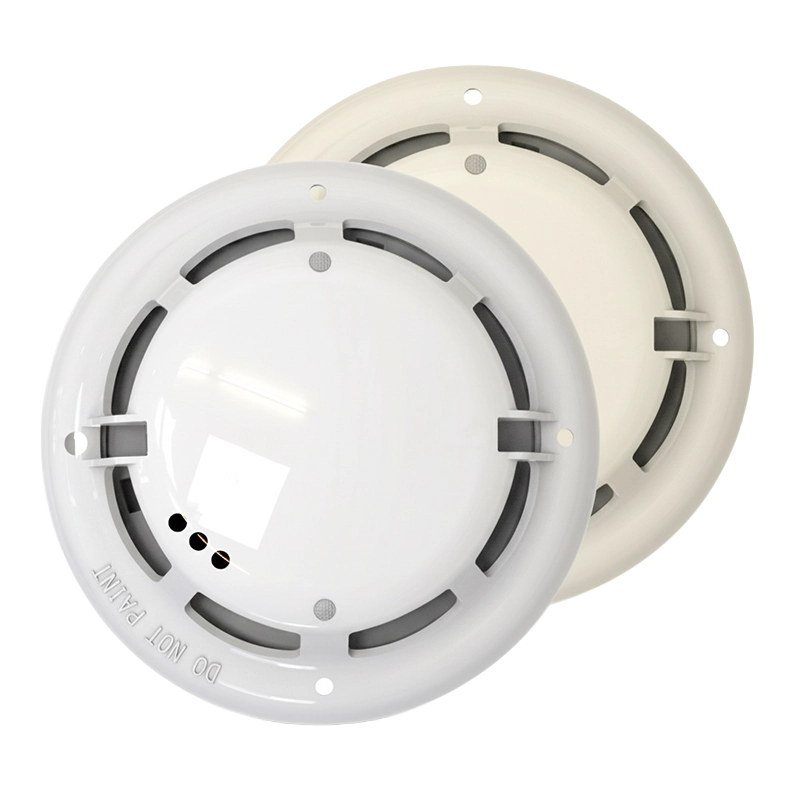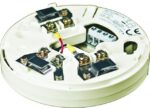Hochiki ACD-EN Addressable Multi-Sensor | Smoke, Heat & CO Detector
£80.64
Summary
The Hochiki ACD-EN is a sophisticated addressable multi-sensor detector that combines smoke, heat, and carbon monoxide (CO) detection capabilities in a single low-profile device. As part of Hochiki’s ESP Intelligent range, this revolutionary sensor offers an impressive 24 EN54-approved operational modes, making it one of the most versatile fire detection solutions available on the market.
Designed for maximum flexibility, the ACD-EN features heat, optical, and CO sensing elements that work independently or in combination to provide optimal fire detection across diverse environments. The detector includes programmable fire threshold levels and a Reduced False Alarm (RFA) function utilizing Hochiki’s groundbreaking SMART (Suitable Moving AveRage Time) algorithm, which automatically adjusts sensitivity based on environmental conditions to minimize unwanted alarms.
Beyond traditional fire detection, the ACD-EN offers COHb (carboxyhaemoglobin) toxicity threat recognition, providing life-saving protection against carbon monoxide poisoning. This makes it particularly suitable for vulnerable populations in settings such as sleeping rooms, hospitals, day care centers, and educational facilities. With day/night mode programming capabilities, fully monitored CO cell operation including end-of-life warnings, and compatibility with Hochiki’s ESP open protocol, the ACD-EN delivers comprehensive protection with complete system flexibility.
Features
- Low profile design at 100mm diameter x 45mm height
- Heat, optical and CO sensing elements operating independently or in combination
- CO Alarm (COHb) facility for carbon monoxide poisoning detection
- Programmable fire threshold level for customized sensitivity
- Remote indicator (RI) and LED controllable separately if required
- 2-colour LED indication (Polling: Green, Fire: Red)
- Reduced False Alarm (RFA) function with SMART algorithm
- Day and night mode programming capability
- Designed for up to 10 year CO cell life dependent on environmental conditions
- Fully monitored CO cell including end of life warning on the panel
- Compatible with ESP open protocol for flexible system design
- Multiple heat classification options (A1, A1R, A1S, C, CR, CS)
- Fixed temperature and rate-of-rise heat detection
- Loop-powered operation requiring no additional wiring
- Available in ivory or white finishes
- Wide operating temperature range from -10°C to +50°C
- Compatible with multiple Hochiki base options
- EN 54-5, EN 54-7, EN 54-26, EN 54-29, EN 54-30, EN 54-31 and CEA 4021 approved
- 3 year warranty period
Video
What is the ACD multi-sensor and what does it detect?
The ACD is a multi-sensor developed for the adjustable ESP sensor range that detects smoke, heat, and carbon monoxide (CO).
How does the ACD help in early fire detection?
The ACD uses CO detection to assist with very early detection of smouldering fires, which release CO gas before visible smoke or flames appear.
What is the purpose of the SMART algorithm in the ACD?
The SMART (Suitable Moving Average Time) algorithm reduces false alarms by automatically adjusting the sensitivity of the optical sensing element based on the environment, learning from multiple samples over time.
How does the ACD monitor for carbon monoxide poisoning?
The ACD has modes that monitor for both sudden high exposure and prolonged exposure to CO, recognizing the threat of carboxyhemoglobin toxic poisoning (carbon monoxide poisoning).
How many operating modes does the ACD have and how can they be changed?
The ACD has 24 operating modes. Modes can be changed easily through the control panel menu by selecting a mode button, applying, and submitting the change.
What do the letters and symbols in the ACD mode strings represent?
Letters represent detection types: S for smoke, FT for fixed temperature heat, ROR for rate of rise heat, CO for carbon monoxide, and COHB for carbon monoxide toxicity. The plus symbol denotes the primary detection element, and the forward slash denotes an element enhancing the primary element.
Can a supporting sensing element generate an alarm by itself?
No, a supporting sensing element cannot generate an alarm by itself; it only confirms the fire decision made by the primary sensing element.
What tools are available to help installers select the correct ACD mode?
There is a Mode Selector tool called the ACD Spinner for quick guidance and a detailed mode guide booklet explaining the modes, the SMART algorithm, and recommended applications.
What protocol does the ACD operate on and what are the benefits?
The ACD operates on Hochiki’s ESP open protocol, providing robust and reliable communication and giving specifiers, installers, and end users an open choice on system design, installation, and maintenance.
FAQ
What are the 24 operational modes and how do I choose the right one?
The ACD-EN offers 24 modes ranging from 9A (default multi-sensor with RFA) to 9D (CO only). Modes combine smoke, heat (fixed temperature and rate-of-rise), CO detection, and COHb toxicity monitoring in various configurations. The default Mode 9A provides smoke detection enhanced by heat and CO with false alarm reduction, suitable for most indoor applications. Heat-only modes (87-8C) are ideal for dusty or steamy environments, while COHb modes (8D-9C) provide life-safety protection in sleeping areas and vulnerable occupancy spaces. Consult the comprehensive Mode Selector Guide to match your specific environmental conditions and protection requirements.
What is the SMART algorithm and how does it reduce false alarms?
SMART (Suitable Moving AveRage Time) is Hochiki’s sophisticated false alarm reduction technology that continually monitors environmental samples and calculates a moving average baseline. When no transient activity is detected, the algorithm gradually reduces the number of samples used, effectively adjusting sensitivity to the stable environment. Any transient activity immediately switches the sensor to maximum sampling to quickly distinguish between real fires and false alarm sources like steam, cooking, or cigarette smoke. This dynamic adjustment ensures the detector remains appropriately sensitive while learning from its environment.
What is COHb detection and where should it be used?
COHb (carboxyhaemoglobin) detection monitors for carbon monoxide poisoning, which can occur from sudden high CO exposure or prolonged exposure over time. The ACD-EN monitors both scenarios and reports alarm conditions when life-threatening CO concentrations are detected. This feature is particularly important in sleeping rooms, hotel rooms, hospital patient rooms, day care centers, and other areas occupied by vulnerable populations (very young and elderly). COHb detection provides early warning of toxic CO levels before serious health effects occur.
What is the difference between the heat classification modes (A1, A1R, A1S, C, CR, CS)?
Heat classifications define the temperature thresholds and response characteristics. A1-series modes have a 60°C fixed temperature alarm, while C-series modes alarm at 88°C. The letters indicate rate-of-rise sensitivity: standard modes (A1, C) activate within 33°C temperature rise, R modes (A1R, CR) activate within faster 19-21°C rises, and S modes (A1S, CS) are static-only with no rate-of-rise component. Choose based on your environment’s normal operating temperature and expected fire development speed.
How long does the CO sensor last and what happens at end of life?
The CO sensing element is designed for up to 10 years of life when installed according to Hochiki’s guidelines and dependent on environmental conditions. The sensor continuously monitors the CO cell’s condition and will send an end-of-life warning to the control panel when replacement is needed. This ensures reliable CO detection throughout the sensor’s operational life and prevents silent failures.
Can I use day and night modes, and how do they work?
Yes, the ACD-EN supports day and night mode programming, allowing different operational modes at different times. This is useful in applications like theaters or classrooms where you might want smoke-only detection during occupied hours (to catch fires quickly) but switch to a heat-enhanced or CO-enhanced mode during unoccupied periods (to reduce false alarms from cleaning activities). The programming is done through the compatible control panel.
What bases are compatible with the ACD-EN?
The ACD-EN is compatible with multiple Hochiki bases including YBN-R/3, YBO-R/SCI, YBN-R/3(SCI), YBO-BS, YBO-BS2, YBO-BS2(SCI), YBO-BSB, YBO-BSB2, and YBV-R/4. Some bases include integral short circuit isolator (SCI) functionality. Choose the appropriate base based on your wiring requirements and whether SCI protection is needed at the device level.
Does the ACD-EN support sleep mode?
No, the ACD-EN does not support sleep mode. The detector maintains continuous monitoring of all active sensing elements to ensure reliable fire and CO detection at all times.
Specifications
- Product Code: ACD-EN (Ivory), ACD-EN(WHT) (White)
- Product Type: Addressable multi-sensor detector with CO detection
- Detection Elements: Smoke (optical), heat (fixed temperature and rate-of-rise), carbon monoxide (CO)
- Operating Modes: 24 EN54-approved modes
- Operating Voltage: 17 – 41 VDC
- Loop Pulse Voltage: 7 – 9 VDC
- Quiescent Current: 410 μA (typical)
- LED Current: 9.1 mA (typical)
- Surge Current: 40 mA (for 50 ms)
- Operating Temperature Range: -10°C to +50°C
- Relative Humidity: <95% RH (at 40°C), <80% RH (at 50°C)
- Storage Temperature Range: -20°C to +50°C
- Colour Options: Ivory, White
- Case Material: Polycarbonate (outer cover), PC/PS-GF (terminal plate)
- Weight Without Base: 105g
- Diameter: 100mm
- Height Without Base: 45mm
- LED Indication: 2-colour (Green for polling, Red for fire)
- CO Cell Design Life: Up to 10 years (dependent on environmental conditions)
- False Alarm Reduction: SMART algorithm in applicable modes
- Compatible Bases: YBN-R/3, YBO-R/SCI, YBN-R/3(SCI), YBO-BS, YBO-BS2, YBO-BS2(SCI), YBO-BSB, YBO-BSB2, YBV-R/4
- Protocol: Hochiki ESP (Enhanced Systems Protocol)
- Sleep Mode Support: No
- Approvals: EN 54-5:2000 + A1:2002, EN 54-7:2000 +A1:2002 + A2:2006, EN 54-26:2015, EN 54-29:2015, EN 54-30:2015, EN 54-31:2015, CEA 4021:2003
- Certification Body: LPCB
- Warranty Period: 3 years
Downloads
- Datasheet (Adobe PDF)
- Mode Selector Guide (Adobe PDF)
Additional information
| Weight | 0.11 kg |
|---|---|
| Detection Type | |
| Device Type | |
| Environment | |
| Protocol | |
| System Type | |
| Colour |








